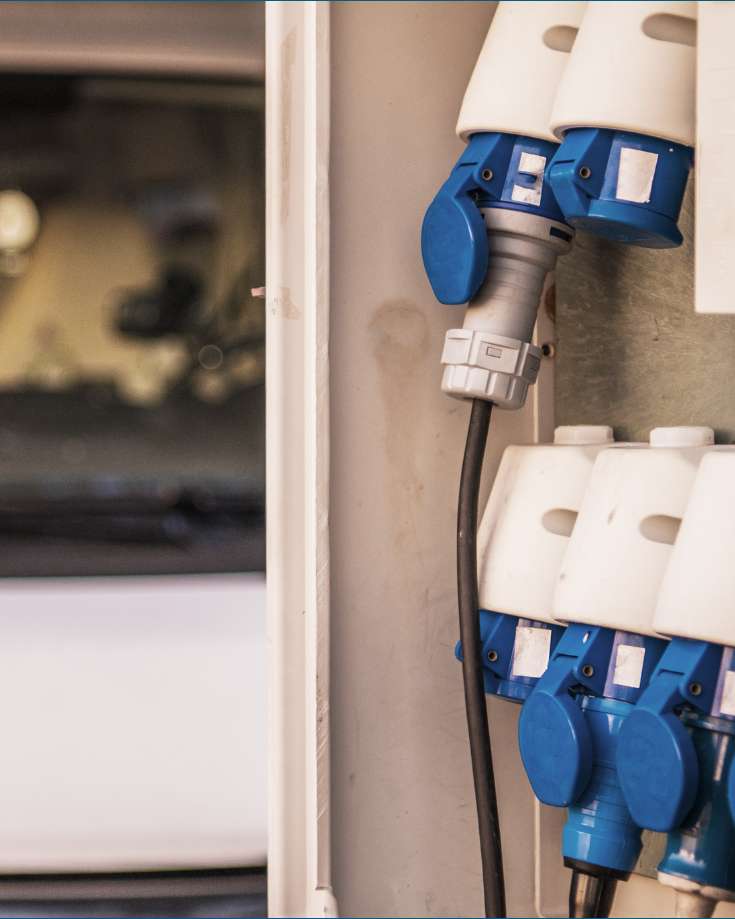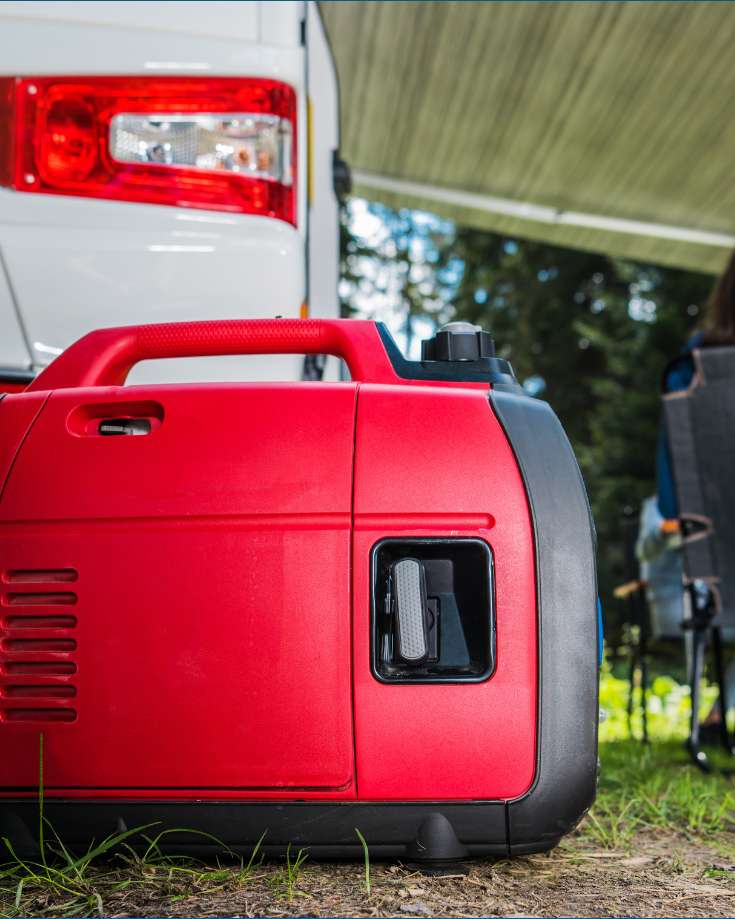Wondering how to charge RV batteries, so you don’t run out of power? We’ll show you the best ways to charge them, from solar power to shore power and more! This easy-to-follow guide shows how to get the most out of your battery life.
Charging your RV batteries is an important part of RV ownership.
After all, you can forget about boondocking without a charged battery bank.
With the rise of solar power technology, there are more ways than ever to ensure your RV’s house batteries stay topped up.
This post will introduce you to the basics of charging your RV’s batteries and discuss the different methods available.
We’ll also cover how to maximize charging efficiency and answer a few common questions about RV batteries.
So if you’re ready, let’s jump into it!
At a Glance: How to Charge RV Batteries in 4 Ways
There are four basic ways to charge RV batteries:
- solar power,
- shore power,
- generator, and
- battery charger.
Before we get into the detail, we’ll quickly look at the different types of RV batteries and the importance of routinely charging them.
Types of Batteries Used in an RV
There are two major types of RV house batteries:
- lead-acid (AGM and Gel), and
- lithium-ion.
Lead-acid Batteries

These are the most traditional type of RV house battery and can be found in many older models. Lead-acid batteries are known for being reliable, serviceable, and reasonably priced.
There’s no need for ongoing maintenance or water refill checks like with the now ancient flood lead-acid batteries. Compared to those old FLA batteries, they’re lightweight and fast charging.
However, battery technology has advanced, and they’re no longer the only option for RV battery banks.
Lithium-ion Batteries

Lithium-ion batteries are the latest in RV battery technology and have become increasingly popular in recent years.
They boast higher capacity, lighter weight, a longer life span, and improved performance over lead-acid batteries.
However, they do come at a higher cost than traditional lead-acid batteries.
That said, when we converted our Class B RV a few years ago, the cost of lithium batteries was still very high. It was a hard sell to convince us they offered better value than AGM or Gel batteries.
But in a few short years, prices of lithium-ion batteries have dropped significantly, and they now represent great value for money.
Demand for lower-cost but less efficient lead-acid batteries has reduced so much that some brands have even stopped selling them.
Many older RVs still have AGM batteries. Until these are phased out or their systems upgraded to lithium, there will always be at least some demand.
However, we suspect the days of a lead acid battery being a serious contender as an RV battery are almost over.
How to Charge RV Batteries from Solar
Charging from solar is one of the most popular options for charging RV batteries. As long as you have ample sunshine, it’s a renewable and free resource.
To charge your RV batteries from solar, you need two main components:
- Solar Panels
- Solar Charge Controller
Solar Panels

Solar panels are photovoltaic (PV) cells that convert sunlight into electrical current. They can generate enough power to charge an RV battery.
Multiple panels can sustain all your energy needs when combined into an array.
They’re also relatively easy to install if you’re handy with tools – all you need is basic knowledge and the right equipment!
When selecting a solar panel for your RV, size does matter. The larger the total panel area, the higher the output voltage it can generate.
You’ll also want to keep in mind factors like temperature range, efficiency level, operating temperature, and weather conditions since these can all impact performance.
Another important consideration when shopping for solar panels is the price. Higher quality products tend to cost more but will last longer than cheaper models, so it pays off in the long run.
Solar Charge Controllers
A solar charge controller is an electronic device that regulates the energy from your solar panel array so it can flow into the battery bank.
Essentially, its role is to manage the amount of current passed to the battery, ensuring it never exceeds the safe limit for your battery system and preventing reverse flow, keeping everything in balance.
There are two types of solar charge controllers available on the market:
- PWM (pulse width modulation), and
- MPPT (maximum power point tracking).
The former is the more traditional option often found in older systems. It offers basic efficiency and protection but won’t give you smart features like optimization or temperature sensing capabilities.
On the other hand, MPPT controllers are the go-to charge controllers thanks to their superior performance compared to their PWM counterparts.
They’re also much more efficient and can increase the power supplied to the battery bank by up to 30% compared to a PWM.
How to Charge RV Batteries with Shore Power

Charging a battery from shore power is one of the best ways to keep your rig up and running while you’re away.
Being able to plug into your residential electricity supply means you can fully charge your battery bank before you leave home.
That will give you some time off-grid and the peace of mind that your RV is ready to go whenever the mood takes you to hit the open road.
Plus, you can use campground facilities to hook up and recharge if you run low on power.
Recharging from shore power is simple, requires minimal effort, and is relatively inexpensive to install.
Most RVs already include a shore power hook-up facility. You can expand that by adding a battery converter (often referred to as a battery charger).
Safety Warning
Mains power voltages are big enough to kill, so if you don’t know what you’re doing, always use a qualified electrician.
How to Charge RV Batteries with Generator Power

Generator charging is another reliable option for charging your RV or campervan battery bank.
Using a generator is the same principle as hooking up your RV to a mains supply.
The only difference is that you plug the generator into an outlet instead of the AC pedestal.
However, you must never connect your generator and main hook-up simultaneously. It could cause serious damage to your RV and any other appliances nearby.
A transfer switch will ensure that it can never happen.
Pros and Cons of Using a Generator to Charge RV Batteries
Pros
- A generator can be an efficient, convenient way to charge your RV batteries when you don’t have access to other power sources.
- Generators are often quite affordable compared to other charging options, such as solar systems.
- They’re relatively easy and straightforward to set up and use – if you follow the proper safety precautions, you shouldn’t run into any problems.
- When properly maintained, generators are long-lasting and reliable machines that can provide energy at almost any time of day.
Cons
- Generators can be noisy because they produce exhaust fumes which could disturb other campers or nearby wildlife.
- Generators need regular maintenance to perform efficiently. This includes checking for fuel or oil leaks and inspecting air filters/cleaners regularly.
- In some areas, there may be restrictions on where and when generators can be used due to noise ordinances or environmental considerations.
- Fuel is required for most generators, so it’s important to remember that you’ll need plenty of extra fuel on hand to keep your generator running throughout your trip.
How to Charge RV Batteries while Driving

How do you charge your RV batteries while you’re on the move? It’s pretty straightforward!
All you need is an alternator, a device found in most vehicles that charge the battery while it’s running.
When you start your vehicle, the alternator will kick in and begin charging your RV battery.
There are two popular methods of using the alternator’s output to keep your RV batteries powered up.
The first is known as split charging. This involves connecting an auxiliary Voltage Sensitive Relay (VSR) between your alternator and leisure battery, optimizing charging according to the battery voltage level.
It ensures that your main engine’s starter battery remains fully charged while providing a constant power supply to your onboard leisure batteries.
The second method is a battery-to-battery charger, which connects two vehicle batteries in parallel and allows one to charge the other. It’s often referred to as a DC-to-DC charger.
This setup is quite versatile and great for RV owners who want the convenience of having two dedicated charging systems – one for the engine and one for their leisure batteries.
Plus, unlike a split charge relay, a smart battery charger can fully recharge the battery.
Alternator charging is a great way to keep your RV battery bank topped up while driving, but it’s important to remember that the alternator can only supply so much power.
For those with higher energy needs, we recommend using the vehicle alternator as a bonus to boost your battery levels.
Technology is moving a quite a pace. Where once the ability to fully charge our RV batteries AND protect the starter battery was only wishful thinking, today, it’s a real possibilty.
The Rego 60A Renogy DC to DC Battery Charger is an impressive piece of technology for anyone looking for a reliable and effective way to charge their battery system.
Its bidirectional charging feature, makes it ideal for those who need to ensure that their battery system stays charged, even when stationary for long periods.
How to Know if Your RV Battery is Fully Charged
How can you tell when your battery is full?
A voltage meter is the simplest way to measure the charge level in your battery. All you have to do is attach it to the terminals of your battery, which will give you a reading.
However, if you’re looking for more advanced solutions, there are plenty of options out there too!
Many higher-end monitoring and power management systems come with features like:
- monitoring liquid levels in your water and waste tanks,
- indicating how much power an appliance uses,
- indicating how much power is generated from your solar panels,
- trigger warnings based on user-defined parameters,
- remote monitoring,
- and more.
No matter what solution you choose, remember to keep a close eye on your RV batteries during long trips – this way, you’ll never have any surprises!

How to Charge an RV Battery at Home
Before setting off on your next camping vacation, it’s best to ensure your RV battery is fully charged.
That’s even more important if you plan on boondocking or dry camping, when you need to rely on less reliable charging sources.
Charging an RV battery at home is a simple process if you have a shore power charging facility:
1. Understand Your RV’s Electrical System
Your RV typically operates on two types of electrical systems: a 120-volt AC system (similar to your home’s electrical system) and a 12-volt DC system (like that of a car or boat).
The 120-volt system powers your RV when it’s connected to an external power source, like a campground hookup or your home’s electrical system.
The 12-volt system is powered by your RV’s batteries and runs your lights, water pump, and refrigerator when you’re not connected to an external power source.
2. Gather the Necessary Equipment
You’ll need your RV’s shore power cord, which is designed to connect your RV’s electrical system to an external power source.
Depending on your RV, this will be either a 30-amp or 50-amp cord. If your home doesn’t have a compatible outlet, you may need to use an adapter.
3. Connect Your RV to Your Home’s Electrical System
To begin charging your RV battery, plug one end of the shore power cord into your RV’s electrical hookup, and the other into your home’s electrical outlet.
4. Activate Your RV’s Built-in Charger
Most modern RVs come equipped with a converter charger, which transforms the AC power from your home into DC power to charge your RV battery. Once your RV is connected to your home’s power supply, turn on the converter charger.
5. Monitor the Charging Process
While your RV battery is charging, it’s important to keep an eye on the process. Overcharging can lead to battery damage.
Although many RV converter chargers have built-in mechanisms to prevent overcharging, it’s still wise to check the battery voltage occasionally.
A fully charged 12-volt battery should read around 12.6 volts.
When your battery is fully charged, remember to disconnect safely.
Start by turning off the charger, then unplug the shore power cord from your home’s electrical outlet, and finally from your RV.
The Fastest Way to Charge RV Batteries
When it comes to charging your RV batteries quickly, shore power is the most efficient method. Let’s delve into why this is the case:
Consistent High Power Output
Shore power, whether at a campground or home, typically provides a consistent 120-volt AC supply.
This steady and robust power source allows for a fast and efficient charge, unlike solar charging or charging while driving which are subject to varying conditions.
Limitations of Solar Charging
While solar charging is an excellent renewable energy solution and works great when you’re off-grid, it has its limitations.
The efficiency of solar charging depends heavily on weather conditions and the position of the sun in the sky.
Cloudy days or a less-than-optimal angle towards the sun can significantly slow down the charging process.
Additionally, solar panels usually provide a lower power output compared to shore power, which means charging times are typically longer.
Limitations of Charging While Driving
Charging your RV batteries while driving seems like a convenient solution, but it’s not the most efficient.
The alternator in your vehicle is primarily designed to maintain the car battery’s charge and power the vehicle’s electrical systems, not to charge an RV battery.
As a result, the amount of power it can send to the RV battery is limited, so charging while driving is generally slower than using shore power.
Converter Charger Efficiency
When connected to shore power, modern RVs utilize a built-in converter charger that transforms the 120-volt AC power into 12-volt DC power suitable for charging your RV batteries.
These devices are designed to charge batteries quickly and efficiently, further enhancing the speed of shore power charging.
In conclusion, while solar and alternator charging have their place and are definitely useful, if speed is your main concern, nothing beats the consistent and powerful supply provided by shore power.
Tips for Optimizing Battery Charging During Long Road Trips
When it comes to keeping your batteries charged on a long road trip, there are several things you can do to ensure that your RV has all the power it needs.
- Plan ahead and ensure you’re not overloading your battery bank with too many electronics – this will help conserve energy and optimize charging time. Use our solar calculator to assess what size solar power system you need.
- Choose the correct size RV battery charger for your battery bank and lifestyle.
- If you’re using a generator, ensure it’s in good working order before hitting the road.
- It’s also a good idea to bring a backup portable power source in an emergency.
- Consider investing in an advanced monitoring system – it’ll give you peace of mind throughout your journey. These systems provide real-time data to keep track of your battery charge levels and ensure they’re always at a safe level.
- If your RV has solar panels, use them to your advantage and let the sun do its job by charging up your batteries during the day. That way, you’ll have plenty of energy for those cool
- Finally, check the charge levels of your RV batteries regularly and top them up with a solar panel or other charging source when needed.
In Conclusion
As RV owners, we must be mindful of our battery charge levels when on the road to have a safe and enjoyable journey.
By following the tips above, you’ll be sure to maximize your battery charge and get the most out of your RV experience.
We hope you found this guide useful and would love to hear any feedback or questions in the comments section below!
Your insights are invaluable and help us create even better content for our readers. So don’t forget to leave us a comment!
Graham Bogie

Graham is a seasoned marine electrical engineer with two decades of experience designing customized electrical systems for plant machinery and converting campers and overland vehicles. His expertise has led him to author the reputable Campervan Electrics Handbook and become the chief designer of the RV Wiring Design Tool. As a knowledgeable figure in the field, his YouTube channel, blog, Facebook group, and newsletter, offering electrical advice and product reviews, reach more than a million users each year.



